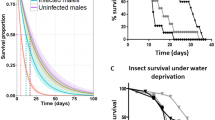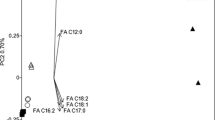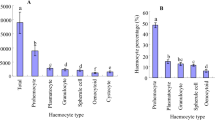Abstract
Lymantria dispar (Lep., Lymantriidae), an important forest defoliator, is host for a variety of entomopathogenic microsporidia. These are obligate intracellular parasites that completely depend on resources provided by the hosts. The microsporidia infecting L. dispar differ in the host tissues that become infected as well as in virulence, with presumably different effects on host physiology. Endoreticulatus schubergi infects the midgut tissue of the host; its virulence is low. We studied the effects of infection with E. schubergi on carbohydrate and lipid levels in the L. dispar host larva. Trehalose titer in the hemolymph increased with larval age. There were no significant differences between infected and uninfected hosts. Glycogen content of the host tissue also increased with age. Levels of this storage carbohydrate were significantly lower in infected larvae at a late stage of infection when insects were either full grown larvae prior to pupation (57.4 ± 5.7 and 36.4 ± 5.2 μg/mg in uninfected controls and infected hosts, respectively) or prepupae (53.2 ± 3.4 vs. 34.7 ± 4.7 μg/mg). Lipid levels in host tissue likewise increased over time and were slightly but not significantly lower in infected L. dispar at a late stage. The results suggest that L. dispar larvae are able to compensate for most of the loss of nutrients to the developing microsporidia. Differences between these findings and the effects of infection with the virulent microsporidium, Vairimorpha disparis, that infects the host’s fat body and causes severe depletion of nutrients in L. dispar larvae are discussed.


Similar content being viewed by others
References
Bauer LS, Nordin GL (1988) Nutritional physiology of the eastern spruce budworm, Choristoneura fumiferana, infected with Nosema fumiferanae, and interactions with dietary nitrogen. Oecologia 77:44–50. doi:10.1007/BF00380923
Becnel JJ, Andreadis TG (1999) Microsporidia in insects. In: Wittner M, Weiss LM (eds) The microsporidia and microsporidiosis. ASM Press, Washington, pp 447–501
Bell RA, Owens CD, Shapiro M, Tardiff JR (1981) Mass rearing and virus production. In: Doane CC, McManus ML (eds) The Gypsy moth: research toward integrated pest management. USDA, Washington, pp 599–600
Bolander F (1996) Zum energetischen Status des Buchdruckers, Ips typographus L. (Coleoptera, Scolytidae). PhD thesis, Ludwig-Maximilians-Universität Munich
Dobart N (2006) Studies on the emergence of Ips typographus L. (Col., Scolytidae) from hibernating sites. Diploma thesis, Universität für Bodenkultur, Wien
Goertz D, Hoch G (2008) Horizontal transmission pathways of terrestrial microsporidia: a quantitative comparison of three pathogens infecting different organs in Lymantria dispar L. (Lep.: Lymantriidae) larvae. Biol Control 44:196–206. doi:10.1016/j.biocontrol.2007.07.014
Henn MW, Solter LF (2000) Food utilization values of gypsy moth Lymantria dispar (Lepidoptera: Lymantriidae) larvae infected with the microsporidium Vairimorpha sp. (Microsporidia: Burenellidae). J Invertebr Pathol 76:263–269. doi:10.1006/jipa.2000.4977
Hoch G, Schopf A (2001) Effects of Glyptapanteles liparidis (Hym.: Braconidae) parasitism, polydnavirus, and venom on development of microsporidia-infected and uninfected Lymantria dispar (Lep.: Lymantriidae) larvae. J Invertebr Pathol 77:37–43. doi:10.1006/jipa.2000.4987
Hoch G, Schopf A, Maddox JV (2000) Interactions between an entomopathogenic microsporidium and the endoparasitoid Glyptapanteles liparidis within their host, the gypsy moth larva. J Invertebr Pathol 75:59–68. doi:10.1006/jipa.1999.4894
Hoch G, Zubrik M, Novotny J, Schopf A (2001) The natural enemy complex of the gypsy moth, Lymantria dispar (Lep., Lymantriidae) in different phases of its population dynamics in eastern Austria and Slovakia—a comparative study. J Appl Ent 125:217–227. doi:10.1046/j.1439-0418.2001.00540.x
Hoch G, Schafellner C, Henn MW, Schopf A (2002) Alterations in carbohydrate and fatty acid levels of Lymantria dispar larvae caused by a microsporidian infection and potential adverse effects on a co-occurring endoparasitoid, Glyptapanteles liparidis. Arch Insect Biochem Physiol 50:109–120. doi:10.1002/arch.10030
Hoch G, Solter LF, Schopf A (2004) Hemolymph melanization and alterations in hemocyte numbers in Lymantria dispar larvae following infections with different entomopathogenic microsporidia. Entomol Exp Appl 113:77–86. doi:10.1111/j.0013-8703.2004.00203.x
Hoover K, Washburn JO, Volkman LE (2000) Midgut-based resistance of Heliothis virescens to baculovirus infection mediated by phytochemicals in cotton. J Insect Physiol 46:999–1007. doi:10.1016/S0022-1910(99)00211-5
Keeling PJ, Fast NM (2002) Microsporidia: biology and evolution of highly reduced intracellular parasites. Annu Rev Microbiol 56:93–116. doi:10.1146/annurev.micro.56.012302.160854
Lee KP, Cory JS, Wilson K, Raubenheimer D, Simpson SJ (2006) Flexible diet choice offsets protein costs of pathogen resistance in a caterpillar. Proc R Soc Lond B Biol Sci 273:823–829. doi:10.1098/rspb.2005.3385
Maddox JV, Solter LF (1996) Long-term storage of infective microsporidian spores in liquid nitrogen. J Eukaryot Microbiol 43:221–225. doi:10.1111/j.1550-7408.1996.tb01395.x
McManus ML, Solter LF (2003) Microsporidian pathogens in European gypsy moth populations. In: McManus ML, Liebhold AM (eds) Proceedings: ecology, survey and management of forest insects, 1–5 Sept 2002, Krakow, Poland. USDA Forest Service, Newton Square, PA. Gen Tech Rep NE-311, pp 44–51
Moret Y, Schmid-Hempel P (2000) Survival for immunity: the price of immune system activation for bumblebee workers. Science 290:1166–1168. doi:10.1126/science.290.5494.1166
Overton K, Rao A, Vinson SB, Gold RE (2006) Mating flight initiation and nutritional status (protein and lipid) of Solenopsis invicta (Hymenoptera: Formicidae) alates infected with Thelohania solenopsae (Microsporidia: Thelohanidae). Ann Entomol Soc Am 99:524–529. doi:10.1603/0013-8746(2006)99[524:MFIANS]2.0.CO;2
Pilarska D, Solter L, Maddox J, McManus M (1998) Microsporidia from gypsy moth (Lymantria dispar L.) populations in Central and Western Bulgaria. Acta Zool Bulg 50:109–113
Pilarska DK, Solter LF, Kereselidze M, Linde A, Hoch G (2006) Microsporidian infections in Lymantria dispar larvae: interactions and effects of multiple species infections on pathogen horizontal transmission. J Invertebr Pathol 93:105–113. doi:10.1016/j.jip.2006.05.003
Rath SS, Prasad BC, Sinha BRRP (2003) Food utilization efficiency in fifth instar larvae of Antheraea mylitta (Lepidoptera: Saturniidae) infected with Nosema sp. and its effect on reproductive potential and silk production. J Invertebr Pathol 83:1–9. doi:10.1016/S0022-2011(03)00038-7
Rivero A, Agnew P, Bedhomme S, Sidobre C, Michalakis Y (2007) Resource depletion in Aedes aegypti mosquitoes infected by the microsporidia Vavraia culicis. Parasitology 134:1355–1362. doi:10.1017/S0031182007002703
Snyder F, Stephens N (1959) A simplified spectrophotometric determination of estergroups in lipids. Biochim Biophys Acta 34:244–245. doi:10.1016/0006-3002(59)90255-0
Thompson SN, Redak RA, Wang L-W (2001) Altered dietary nutrient intake maintains metabolic homeostasis in parasitized larvae of the insect Manduca sexta L. J Exp Biol 204:4065–4080
Thompson SN, Redak RA, Wang L-W (2005) Nutrition interacts with parasitism to influence growth and physiology of the insect Manduca sexta L. J Exp Biol 208:611–623. doi:10.1242/jeb.01404
Vinson SB, Iwantsch GF (1980) Host suitability for insect parasitoids. Annu Rev Entomol 25:397–419. doi:10.1146/annurev.en.25.010180.002145
Weidner E, Findley AM, Dolgikh V, Sokolova J (1999) Microsporidian biochemistry and physiology. In: Wittner M, Weiss LM (eds) The microsporidia and microsporidiosis. ASM Press, Washington, pp 172–195
Wittner M (1999) Historic perspective on the Microsporidia: expanding horizons. In: Wittner M, Weiss LM (eds) The microsporidia and microsporidiosis. ASM Press, Washington, pp 1–6
Zwölfer W (1927) Die Pebrine des Schwammspinners und Goldafters, eine neue wirtschaftlich bedeutungsvolle Infektionskrankheit. Z Angew Ent 12:498–500
Acknowledgments
We gratefully acknowledge the support by the Austrian Academy of Sciences for D.K.P., and particularly Prof. Gerhard Glatzel for inviting her as visiting scientist to BOKU University. We thank Andrea Stradner and Gabriele Motlik for technical assistance and Dr. Christa Schafellner for her advice with biochemical analysis and discussions on an earlier draft of this manuscript. Additional funding for this research came from USDA FS cooperative agreement 04-IC-11242343-100.
Author information
Authors and Affiliations
Corresponding author
Additional information
Communicated by A. J. Storer.
Rights and permissions
About this article
Cite this article
Hoch, G., Pilarska, D.K. & Dobart, N. Effect of midgut infection with the microsporidium Endoreticulatus schubergi on carbohydrate and lipid levels in Lymantria dispar larvae. J Pest Sci 82, 351–356 (2009). https://doi.org/10.1007/s10340-009-0260-2
Received:
Revised:
Accepted:
Published:
Issue Date:
DOI: https://doi.org/10.1007/s10340-009-0260-2




